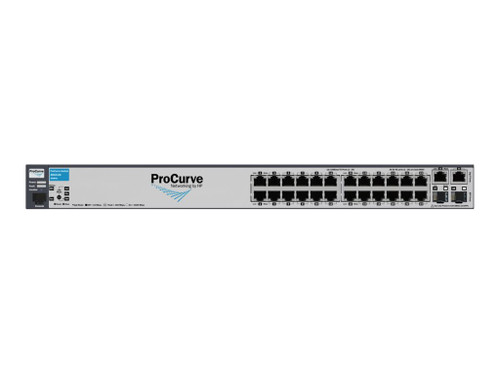Highlights
- Class of Service (CoS): sets the IEEE 802.1p priority tag based on IP address, IP Type of Service (ToS), Layer 3 protocol, TCP/UDP port number, source port, and DiffServ
- IEEE 802.3af Power over Ethernet (PoE): provides up to 15.4 W per port to IEEE 802.3af-compliant PoE-powered devices such as IP phones, wireless access points, and security cameras
- IEEE 802.3ad Link Aggregation Protocol (LACP) and HPE port trunking: support up to 24 trunks, each with up to 8 links (ports) per trunk
- RMON, XRMON, and sFlow: provide advanced monitoring and reporting capabilities for statistics, history, alarms, and events
Marketing description
The HPE 2610 Switch Series consists of five switches. The HPE 2610-24 and 2610-48 Switches provide 24 and 48 ports of 10/100 connectivity. The HPE 2610-24 Switch is a fanless switch with quiet operation, making it ideal for deployments in open spaces. The HPE 2610-24-PPoE, 2610-24-PoE, and 2610-48-PoE Switches are IEEE 802.3af compliant for Power over Ethernet (PoE) and provide up to 15.4 W for 12, 24, and 48 ports. The 2610-24-PPoE switch has 24 10/100 ports and provides 12 ports of PoE. All series switches include two 10/100/1000BASE-T ports and two mini-GBIC slots for Gigabit Ethernet uplink connectivity. An optional redundant external power supply is also available to provide redundancy in the event of a power supply failure. With static routing, robust security and management features, free lifetime warranty, and free software updates, the HPE 2610 Switch Series is a cost-effective solution for customers who are building converged enterprise edge networks.
Product Features
- Quality of Service (QoS)
Class of Service (CoS): sets the IEEE 802.1p priority tag based on IP address, IP Type of Service (ToS), Layer 3 protocol, TCP/UDP port number, source port, and DiffServ.
Layer 4 prioritization: enables prioritization based on TCP/UDP port numbers.
Traffic prioritization (IEEE 802.1p): allows real-time traffic classification into eight priority levels mapped to four queues. - Connectivity
IEEE 802.3af Power over Ethernet (PoE): provides up to 15.4 W per port to IEEE 802.3af-compliant PoE-powered devices such as IP phones, wireless access points, and security cameras.
Gigabit uplink connectivity: two 10/100/1000BASE-T ports and two mini-GBIC ports for connectivity such as Gigabit Ethernet (SX, LX, LH, and 1000BASE-T) and 100BASE-FX.
Auto-MDIX: automatically adjusts for straight-through or crossover cables on all 10/100 ports.
Jumbo packet support: supports up to 9216-byte frame size to improve performance of large data transfers. - Resiliency and high availability
IEEE 802.3ad Link Aggregation Protocol (LACP) and HPE port trunking: support up to 24 trunks, each with up to 8 links (ports) per trunk.
IEEE 802.1s Multiple Spanning Tree: provides high link availability in multiple VLAN environments by allowing multiple spanning trees; provides legacy support for IEEE 802.1d and IEEE 802.1w.
Optional redundant power supply: provides uninterrupted power (provided by HPE 600 RPS/EPS). - Manageability
RMON, XRMON, and sFlow: provide advanced monitoring and reporting capabilities for statistics, history, alarms, and events.
Uni-Directional Link Detection (UDLD): monitors a link between two switches and blocks the ports on both ends of the link if the link goes down at any point between the two devices.
Command authorization: leverages RADIUS to link a custom list of CLI commands to individual network administrator's login; also provides an audit trail.
Multiple configuration files: allow multiple configuration files to be stored to a flash image.
Dual flash images: provides independent primary and secondary operating system files for backup while upgrading.






